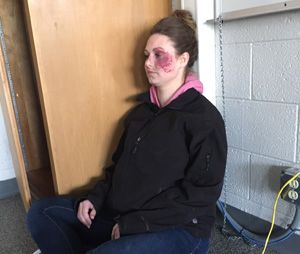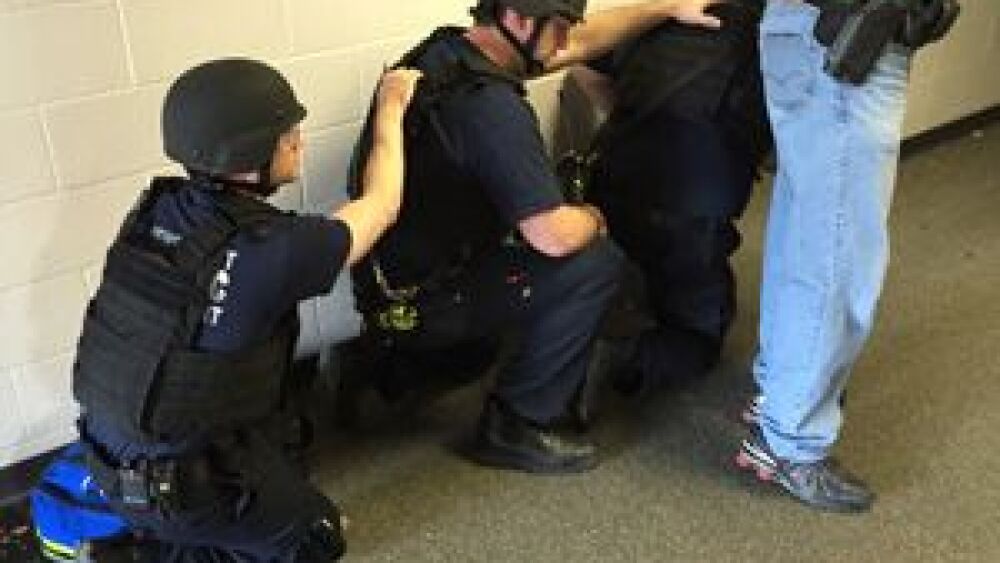STEVENS POINT, Wis. — Paramedics and police officers from throughout Portage County (Wis.) completed ‘Rescue Task Force’ (RTF) training for an active-shooter incident response with the shared goal to save more lives.
“Be assertive with those calls,” said MPO/Paramedic Art Dahms.
He was positioned just behind a police officer that was leading him and two other paramedics into a hallway strewn with shell casings. The medics sought cover while the police cleared a classroom of active threats and patients.
“Medic up, medic up,” called an officer to Dahms. “We have two patients with gunshot wounds.”
Dahms’ RTF began treatment of the patients as part of a joint hands-on training, conducted in an empty college building. As the medics began to work on the patients the officer stepped back into the hallway.
“Never leave the medics,” shouted a trainer to the cops assigned to Dahms’ RTF.
With repetition and instructor feedback the RTF improved its teamwork, calling out actions and needs, and moving as a compact unit in and out of the warm zone.
The response agencies in Portage County (Wis.) are similar to most places in the U.S. A big incident, like an active shooter, will require every agency and all available personnel, regardless of department affiliation to respond. Representatives of several departments completed the Rescue Task Force training in Milwaukee and brought it back to the leaders of the various police, fire, and EMS agencies in the county. Adoption of the RTF concept by the agencies that will inevitably respond together to an active-shooter incident was an important step in the philosophical shift about EMS working in areas not declared officially safe by law enforcement.
The Rescue Task Force for active-shooter incidents
The hands-on RTF training program, utilizing dozens of simulated patients, allowed responders to work together on team techniques and clear communication to find, triage, treat and extricate patients in the warm zone.
“The RTF teams rotate through four scenarios and you can see their techniques improve as they gain experience,” said EMS Lt. Jason Olds, firefighter/paramedic for the Amherst (Wis.) Fire Department.
The scenarios culminated a months-long planning and preparation process between the Stevens Point Fire and Police Departments, Amherst Fire Department, Portage County Sherriff’s Office, and more than half-a-dozen additional neighboring EMS, police and fire agencies.
“In the final scenario there are more than 20 patients for the RTFs to find and extricate from the building. We add more noise and visual distractions in the final scenario,” said Olds.
Rapidly find and treat patients in the warm zone
Implementation of the RTF is recognition that the most lives will be saved from severe bleeding or airway compromise if EMS is able to access patients well before a scene can be declared officially safe.
“We work together to move the medics in quickly to save people quickly,” said Deputy Robert Wanta of the Portage County Sheriff’s Office.
An RTF is deployed after an initial law enforcement entry team has either neutralized the shooter or isolated the shooter to another area. The shooter(s), until killed or arrested, is in the hot zone.
Even though the shooter is gone, the warm zone may still have other dangers like improvised explosive devices. Perhaps an injured shooter has attempted to disguise himself as a patient.
“This training is about departments from many communities getting on the same page with the RTF technique,” said Wanta
Cooperative response with law enforcement
The RTF deploys police officers and paramedics, each with assigned roles, to enter and search the warm zone. The police officers provide an armed escort, experience and expertise at identifying previously unseen or unmitigated threats.
“Our medics learn the tactics officers use to move into and through rooms,” said Lt. Ron Hiebler, a firefighter/paramedic and RTF coordinator for the Stevens Point Fire Department.
“The RTF incorporates EMS into the police process and gets medics to patients faster. At the same time the officers learn to slow down and be responsible for EMS.”
As the police systematically enter rooms and identify the presence of casualties the medical personnel, wearing helmets and ballistics vests, use concealment and cover, behind walls and officers.
“It is new to us to be working in the warm zone,” said Assistant Chief Jeff Davis of the Stevens Point Fire Department. “We are learning to work and interact with the cops, use our wits, and not get tunnel vision.”
Treat and move, treat and move, treat and move
The mantra for the RTF is to treat and move, treat and move, always moving forward, until all patients are treated or the equipment bag is empty. The RTF is equipped with tourniquets, hemostatic gauze and pressure dressing for severe hemorrhage, chest seals for open chest wounds and needles for chest decompression.
“The RTF only treats life threats,” said Hiebler. “Only if the RTF is out of equipment or out of patients will the team begin to move patients.”
The uninjured and walking wounded are expected to self-evacuate before the RTF reaches them or if they shelter-in-place to walk out following specific directions from the RTF. Other patients, depending on the severity of their injuries, will be carried or dragged out by the RTF or wait for an extrication team.
RTF medical personnel responsibilities
The paramedics in the RTF have pre-assigned roles. The lead paramedic is positioned directly behind the police escort and maintains radio contact with the RTF medical supervisor and relays verbal instructions to the other medics. Additional medics, moving in a single file stack behind the lead paramedic, keep their hand on the shoulder or vest of the medic in front of them. The final medic in the stack carries the RTF bag.
When the police have cleared a room and identified victims they call in the paramedics. In a four-person team the second and third medics assess and treat patients. They call out for supplies from the medical bag, managed by the fourth medic, and relay patient triage status to the lead medic who in turn radios that information to the RTF supervisor.
 |
| “Is she really pregnant or is a bomb around her waist?” asked paramedic Shirley Allen, Amherst Fire Department to her RTF. (Image Greg Friese)
|
Tunnel vision is the #1 enemy
A consistent theme throughout the training was to not get tunnel vision, such as overly focusing on the screams of one injured patient while missing a more severely injured patient or an improvised explosive device.
In one classroom, a female patient was positioned in the corner wearing a bulky coat and she had wounds to her face. Many officers and paramedics overlooked the potential risks of the awake, but very still and quiet patient.
“Is she really pregnant or is a bomb around her waist?” asked paramedic Shirley Allen, Amherst Fire Department to her RTF.
The trainers intentionally wanted to present scenarios that challenged the assumptions rescuers were making about patients. Although this patient had a fake pregnancy belly the trainers wanted the RTF to closely consider the potential risks of all patients. In another room a patient with a blood-soaked shirt and blood-covered hands aggressively walked towards the officers as they entered the room.
“The officers should be checking the patients for weapons and bomb vests,” said Olds.
Valuable real-world experience for students
The patients for the RTF training exercise were criminal justice, corrections, and paramedic students. For many the free training was valuable real-world experience and well worth a day away from spring break activities.
“It’s free training on clearing a room and being cautious,” said Kris Marchel, a criminal justice student who is launching a second career as a police officer.
Even though they were patients, the students were closely watching the seasoned professionals enter and clear rooms. The two most important lessons for many students were to not get tunnel vision and rely on their training for search techniques.
“I was a patient that was hidden behind the door to the room. An officer that entered was focused on an easily visible patient across the room and didn’t see me until he left the room,” said one of the students.
Students were able to see and understand how different room search techniques work.
“Each department and officer might have their own way of searching or clearing a room. I was able to see the techniques we have discussed in the classroom,” said Stephanie Laug, a corrections student at Mid-State Technical College.













